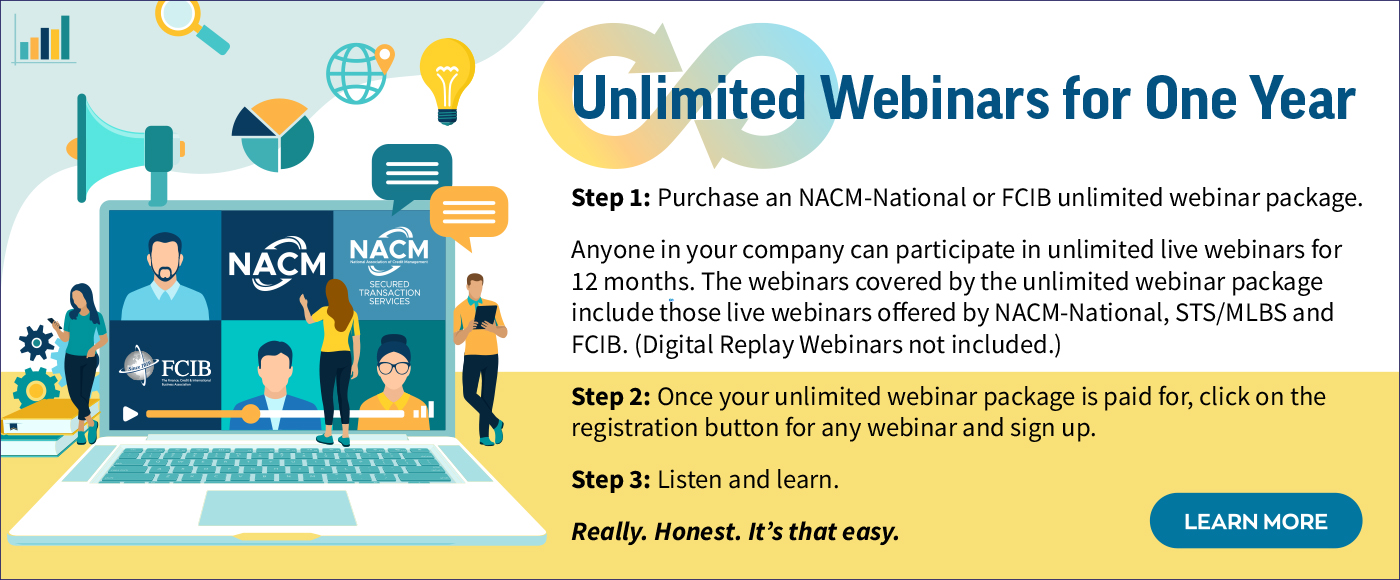eNews January 21
In the News
January 21, 2021
And So It Begins
Chris Kuehl, Ph.D., NACM economist
The Trump era has ended, and the Biden era has begun. While the shift from one president to another is certainly an important transition, the reality is that all the problems and challenges of the previous administration will be there for the next one.
What can we expect under President Joe Biden? What will his priorities be? There is a lot on the agenda for the short term, medium term and long term. The next 100 days will be significant. This is always viewed as the honeymoon period for a new leader. There have been many clues already as far as what Biden would like to accomplish, but now that policymaking kicks into high gear there will be a major contest over what gets attention first.
The top priority is no mystery. Biden will have to jump squarely into the pandemic and lockdown crisis right away. Nothing else on the agenda will matter much as long as the virus dominates political and economic thinking. It will be a four-phase process and has been partially addressed already.
The first and most urgent step is mass distribution of the vaccine and that means getting the barriers out of the way. It has not helped that this is still not a true federal effort. States and cities are still in charge, and there is wide variety in how the vaccine has been rolled out.
The second step will be pushing more support and relief through the system. There has been a subtle switch in terms. This is now being referred to more accurately as a rescue rather than a stimulus per se. The economic stimulus that is required is an end to the lockdowns that have cut consumers off from the service sector. Until that happens those who have been most adversely affected by the past year need immediate help.
The third step is the reopening. That could be extremely messy as there will be no national mandate. It will still be in the hands of states and communities. That means a chaotic array of decisions. Some will open too soon and invite more virus spread; others will delay too long and risk further economic damage. There has not even been agreement on when “herd immunity” can be reached.
Perhaps the very hardest step will be getting the general population to accept the crisis has come to some kind of an end. There will not be a point when there are no infections, hospitalizations and deaths. The vaccine will not work 100% of the time. The threat and danger will be much reduced, but it will be there. People will have to decide what they are willing to do.
This process will dominate the first part of this year and perhaps longer. All of this has pushed some of Biden’s other priorities to a backburner for a while. Look for emphasis on the following seven areas: infrastructure, trade, climate change, taxation, health care, financial reform and technology. There are a couple of themes that have started to evolve.
The first is that Biden may be a more aggressive delegator than either Donald Trump or Barack Obama and will let the people in his Cabinet run with their assigned duties. He may even be somewhat Reaganesque as he plays the role of final arbiter. Obama was a consummate micro-manager and had his fingers in everything. Trump was a meddler.
If there is a discernible theme this early in the process, it is that Biden favors the carrot over the stick. When it comes to trade, he has emphasized export promotion over restriction of imports. The goal is to promote jobs through global trade rather than punish other nations for selling to the U.S. His climate change tactic is to boost interest in alternatives. There has been a suggestion that a national infrastructure effort be geared toward building a network of charging stations so electric vehicles become more practical. His technology initiatives similarly seem to rest on issues such as rural broadband access. Tax and financial sector reform also seem slanted toward finding ways to make money work harder for the overall population by opening up the system and creating tax incentives for people to put their money to work.
At this point, this is all speculation because Biden has only stepped behind the desk. He will have to determine how he will work with a fractured Democratic Party. The divisions within his own party have been less obvious as the focus has been on Trump. Now the infighting really begins in a party that hosts everyone from Bernie Sanders to Joe Manchin.
Letters of Credit in a Digital Age
Michael Miller, NACM managing editor
Two banks in Asia have broken ground in cross-border transactions. City Bank announced earlier this month that it became the first Bangladeshi bank to execute a cross-border letter of credit (LC) under Shariah-based financing using blockchain.
The transaction between a Bangladeshi garments business and a Hong Kong-based exporter was conducted on Contour’s network. From draft initiation to issuance and advising, the LC took 38 minutes. Meanwhile, HDBank announced it became the first Vietnamese bank to conduct such a transaction, which took place between a fiber importer and a Taiwanese yarn manufacturer.
The use of blockchain in LC transactions is increasing, according to BTCManager. “Blockchain offers better security and faster processing of transactions,” the news outlet reported. “It also minimizes errors that are common with paperwork and saves time. Blockchain as a distributed ledger enables the storage of huge data of statistics, management data, and historical transactions between customers.”
The use of this technology is not without complications and challenges. In many ways, digitizing and securitizing the documents with encryptions is the easy part compared to the navigation of international regulations.
An electronic uniform customs and practices (eUCP) process has been governed by the International Chamber of Commerce (ICC) for several years, said Chris Pilkington, international banking relationship manager with First National Bank. Yet, each sovereignty has its own digital document laws and some don’t have any.
Not every bank around the world will have the same technological expertise. Even within a country, different technologies are used. On the positive side, commodity shipments with LCs can be done totally digitally because the entire vessel of product is going from one seller to one buyer, not different products belonging to multiple shippers, Pilkington noted. However, this is not yet the norm.
The first webinar of a four-part LC series hosted by FCIB begins Thursday, Feb. 4. LC expert Richard “Chip” Thomas will present a four-part LC series starting Thursday, Feb. 4. Each session focuses on a different aspect of LCs.
European Businesses Confident About Economic Rebound
in 2021
Silvia Ungaro, Atradius
Respondents to Atradius’ annual Payment Practices Barometer (PPB) on Western and Eastern Europe believe conditions are likely to improve for European economies soon despite the continuation of the pandemic. The PPB assesses business payment behavior and provides a snapshot of credit risks and how companies use trade credit insurance.
As a result of the Covid-19 pandemic, reduced consumption and supply side shocks have severely upset the global economy. The 2020 survey shows businesses throughout Europe felt the greatest impact on business revenue. In Greece, 69% of businesses reported an impact on revenue with a 64% impact on sales volume and a 55% impact on cash flow. Slovakia and Bulgaria saw a similar impact, while Turkey reported one of the smallest negative impacts on revenue, cash flow and sales volume.
Overdue Invoices on the Rise
The onset of the pandemic was felt differently amongst European countries. Countries such as Italy and France may have started in a stronger place when the pandemic began, but they progressively felt the economic consequences worsen as lockdowns went into place.
For many businesses, the collection of outstanding invoices is a major concern. According to the survey results, 38% of businesses in Europe worry about unpaid balances. In the Netherlands, 20% of businesses said that collecting outstanding invoices will be a challenge for them in 2021.
Late payments have severe consequences on the global economy, disrupting supply chains and creating financial distress worldwide.
Leveling Up Credit Management
While many businesses throughout Europe took initiative through self-insurance in 2020, nearly three in five businesses surveyed reported that they have used credit insurance during the pandemic and will continue to use it going into 2021.
Turkey has taken a strong, proactive approach to credit management in past years, but especially in 2020. Businesses in Turkey expressed that they will continue using trade credit insurance in the coming years, which is a distinctive feature of Turkey’s success.
The months ahead are critical to economic recovery. If 2020 has taught businesses one thing, it is that trading safely and protecting accounts receivable are crucial in a volatile business environment.
Improved B2B Transactions, Improved Trade Relationships
On a positive note, the survey results made it clear that due to the need for continuous communication, businesses throughout Europe reported that their trade relations with buyers significantly improved in 2020.
The constant exchange of information and more favorable payment terms, thanks to credit insurance tools, allow buyers to be more confident purchasing from suppliers, therefore improving relations throughout Europe.
As with several economies worldwide, the informal and nonessential sectors, such as tourism and hospitality, still see a long, tiresome road ahead. On the other hand, sectors such as chemicals and agriculture are positioned to recover more quickly in the months ahead. The ICT/electronics industries share a positive outlook about the future. More than half of European businesses operating in the electronics industry expect to see improvement in the domestic economy in the coming months, with Hungarian businesses particularly optimistic.
One major takeaway from the survey results is that while European economies have seen struggles, businesses throughout the continent are hopeful, particularly for domestic trade. Using trade credit insurance, many European businesses have been able to invigorate the domestic economy, speeding up a recovery for international trade.
As the pandemic slowly subsides, businesses throughout Europe are confident in their prospects and are eager to see the global economy improve over the next year.
Silvia Ungaro is a corporate communications manager at Atradius, a global trade credit insurer. She is responsible for the Payment Practices Barometer survey of B2B payment behavior.
Commercial Chapter 11 filings increased 29% during calendar year 2020—7,128 compared with 5,519 in 2019, according to the American Bankruptcy Institute. The filing total was the highest since the 7,789 filings registered in 2012. Numbers are expected to rise for a while as government assistance and other programs come to an end.
This article provides a wealth of tips that credit professionals should consider when a customer files for bankruptcy.
Notice of Bankruptcy Filing
Customers may tell you or provide written notification that the company has filed for bankruptcy. Ask your customer for a case number and the name of the court where the bankruptcy was filed so that you can verify the filing. NACM industry trade groups are another place to learn about customer bankruptcies. You can also sign up for electronic notices through the bankruptcy noticing center through the U.S. Courts’ website.
Discern which chapter of the bankruptcy code a voluntary or involuntary petition is following. If the debtor is a related company in the corporation, seek legal advice. For example, if you ship to one company, but you are paid by the other.
A servicing agent appointed by the bankruptcy court will create and service a local website for most large cases. These websites are a goldmine of information. The servicing website rather than the court will often file the proof of claim. These websites also provide general information about the U.S. trustee, the case number and professionals employed by the debtor.
In smaller cases, ask customers or their attorneys to send copies of documents. Once a proof of claim is filed, request that you receive notices and motions in the case directly to avoid a lockbox situation. In complex cases, it may pay to hire an attorney to represent you and get copies of documents.
Critical Information
Look for the exact name of the filer and confirm whether it is your customer. It might be another business within the same corporation. Check the EIN. Petitioning creditors, in smaller cases, sometimes have the largest claims in the case.
It is now common for the filing of a schedule of claims and assets to be filed later in the case. This gives creditors an opportunity to see how much the company has in assets and liabilities and if they are listed as a creditor by the debtor. The statement of affairs, also filed later in the case, gives information such as income in the year of the bankruptcy up until the petition date as well as the company’s revenue the year prior.
Operating reports are filed monthly, starting with the month after the case is filed. This is a snapshot of financial information for the last month. Copies of bank statements are important. In smaller cases, the operations report can help determine whether to ship goods to the customer despite the debtor’s assurance it can make payment.
In medium to large cases, a DIP financing motion means companies cannot operate solely based on the cash they generate. Most of the time, they need a loan. Lookout for a budget that the bankruptcy court provides on how the cash will be used. Review what the debtor proposes to pay unsecured creditors. To continue using the cash, the debtor must meet benchmarks such as file the plan by a certain date, sell assets by a certain date, and so on. Failing to hit the benchmarks results in the inability to borrow money unless the lender agrees to an extension. Small cases have similar problems; there’s just less money involved.
In medium to large cases, the declaration or affidavit will show the cause of filing and whether the business is still operating. In smaller cases, creditors should check if the customer has any secured debt and how it proposes to pay for goods or services delivered after the case is filed.
Something new this year is the revision of the code with the Small Business Reorganization Act/Subchapter V of the Chapter 11 code. The passing of the CARES Act earlier this year also raised the debt ceiling under the new subchapter to $7.5 million. This means creditors’ committees will not be appointed and the disclosure statement and plan can be joined in one document and heard at one hearing.
Calculate Your Claim and Evaluate Risk
Gather all documents related to the claim and contracts. Review outstanding invoices and reduce the claim by any agreed returns or credits. Determine whether the customer has disputed any part of the claim and whether you agree with the dispute. Identify whether the claim is secured by any lien or retainage as well.
Identify potential issues such as a preference claim. Do you have any unsecured claims? Did you receive payment within 90 days of the petition date? Was payment made on an outstanding invoice, was it a payment in advance or was it at the time of delivery?
The top priority is to get your documents in order and analyze your claim. Large claims or problems with documents might require legal advice even before filing a proof of claim. If the debtor demands that you provide goods and services post-petition, demand to see copies of motions approving the use of cash collateral or DIP loan with the proposed budgets.
|
Upcoming Webinars |
|
Jan 26 |
Key Performance Indicators (KPIs) and Metrics for Your Financial Close Speaker: Chris Doxey, CAPP, CCSA, CICA, CPC, Doxey Inc., Paeonian Springs, VA |
| Risk Mitigation in Mexico in a Nutshell: Due Diligence & Secured Transactions Speaker: Romelio Hernandez, HMH Legal S.C., Tijuana-Baja California, Mexico |
Jan 28 |











